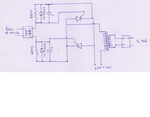swapan
Full Member level 4
Hi Friends,
In a Home UPS available in India I have noticed that charging the battery (150 – 200 AH, Lead Acid) is done by using the same transformer tapped at nearly 130V. AC mains (generally 220 V) is given to that tap controlled by SCR/TRIAC, fired at required angle so that charging current is maintained at certain level. I have undertaken to make such a charging system using PIC MCU. When testing, it is seen that the project works well except a problem at a particular point. If the firing angle is set near zero crossing point ( say at 10 degree and 190 degree of a cycle), a horrible humming is produced in the transformer and sometimes the AC mains fuse is blown without any charging current. But beyond that point the circuit works smoothly.
I guess that due to lagging of current behind voltage and firing of thyristor this humming is produced. I request you to offer your valued comment please.
In a Home UPS available in India I have noticed that charging the battery (150 – 200 AH, Lead Acid) is done by using the same transformer tapped at nearly 130V. AC mains (generally 220 V) is given to that tap controlled by SCR/TRIAC, fired at required angle so that charging current is maintained at certain level. I have undertaken to make such a charging system using PIC MCU. When testing, it is seen that the project works well except a problem at a particular point. If the firing angle is set near zero crossing point ( say at 10 degree and 190 degree of a cycle), a horrible humming is produced in the transformer and sometimes the AC mains fuse is blown without any charging current. But beyond that point the circuit works smoothly.
I guess that due to lagging of current behind voltage and firing of thyristor this humming is produced. I request you to offer your valued comment please.
